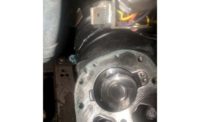HVAC distributor cfm Distributors recently developed a list of items to test and/or questions to ask when dealing with sites that have experienced multiple failed compressors. The first step consists of determining the compressor’s mode of failure. Was it electrical or mechanical? This piece focuses on electrical failures. A piece on mechanical failures will follow.
If it’s an electrical failure, the first thing to do is check line voltage at the load center with the compressor off. Low line voltage causes the motor to draw more current than normal and may result in overheating and premature failure. Line voltage that is too high will cause excessive inrush current at motor start, again leading to premature failure. Then check line voltage at the motor terminals with the compressor running. The voltage should be within 10% of the motor rating.
After that, check the running current. The readings should not exceed the manufacturers' full-load rated amps during heavy load periods. Low amps are normal during low-load conditions. Excessive high current may be due to shorted or grounded windings, a bad capacitor, a faulty start relay, or an indication of excessive bearing fatigue.
When performing electrical measurements on compressors with internal thermal motor protection devices that have been running extremely hot, be sure to give the compressor time to cool down prior to the electrical test. This will allow the device to reset to its normal position.
If a technician suspects an acid burnout has occurred, causing the compressor’s electrical failure, it is good practice to conduct an acid test. If the system shows elevated acidity, flush the system with an approved flush and perform a triple evacuation.
If the system uses three-phase equipment, verify proper phasing. To do this, attach a pressure gauge to the suction line of the compressor and bump the compressor contactor to verify that the suction pressure decreases. Or use a phase monitor or phase tool. Be cautious when verifying phasing by checking rotation of blowers and condenser fans. In most cases, blowers utilize a VFD, and single-phase condenser fan motors are commonly utilized in three-phase equipment by using power from L1 & L3.
To test OHM values on either type of motor, disconnect the power. Then gain access to the compressor terminals. Unplug the 3-prong plug on the compressor and set the multimeter to ohms. Measure and record the resistance (ohms) measurement of each winding. When testing the OHM value of the compressor, all legs (L1-L2) ( L1-L3) (L2-L3) should be the same from leg to leg. An ohm value / continuity should be tested each leg to ground. This reading should always read OL / no resistance.
With single-phase motors, verify that the run capacitor UF rating tests within specification. The lowest reading should be below 10 ohms (this is the run winding). The second highest reading should be about 2-4 times higher than the lowest reading (this is the start winding).The highest reading should be the sum of the resistance read across the two smaller windings. If any of these readings read infinite or over range on the ohm meter, there is an open winding. A reading of zero ohms indicates a short in a winding.
There are three main types of winding failures. An open winding is when one of the wires that make up the motor windings is broken or separated. A shorted winding happens if the insulation on the windings has failed; sometimes one part of the winding is making electrical contact with another part of the winding. A grounded winding is similar to the shorted winding, but the wire with the broken insulation is making electrical contact with the compressor casing or ground.
When performing electrical measurements on compressors with internal thermal motor protection devices that have been running extremely hot, be sure to give the compressor time to cool down prior to the electrical test. This will allow the device to reset to its normal position.











